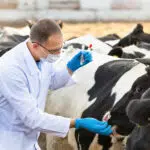World Zoonoses Day is observed annually every July 6. This day aims to shed light on diseases that originate in animals that can be transmitted to humans. In a study by the C.D.C., 60% of all existing infectious diseases are zoonotic and at least 70% of emerging infectious diseases originate in animals.
History of World Zoonoses Day
On July 6, 1885, French biologist Louis Pasteur successfully administered the first rabies vaccine to a little boy bitten by a rabid dog. The vaccine not only prevented the child from getting rabies; it saved his life.
Rabies is just one example of many zoonotic diseases. Avian influenza, Ebola, and the West Nile Virus are some other examples that have been discovered over the years. Zoonotic pathogens can be viral, bacterial, or parasitic and can spread to humans through direct contact or indirectly through food, water, or the environment. It may even spread through an intermediary species. It does not just originate from wild animals like bats or monkeys. It can also come from pets and farm animals. The use of antibiotics in animals raised for food increases the potential for drug-resistant strains of zoonotic pathogens. That’s why animals have an important role in zoonotic infections.
As there are many types of Zoonotic diseases, there are also many types of treatments such as antibiotics. Some practices can help prevent the spread of foodborne zoonotic diseases like safe guidelines for animal care in the agriculture industry. Having access to clean drinking water and proper waste removal are effective ways to reduce the spread of diseases. Vaccinating household pets and maintaining proper hygiene like washing your hands after close contact with animals can also help.
Protecting and managing the health of animals that live alongside humans is vital. When we prevent diseases in animals, we safeguard the health of people.
World Zoonoses Day timeline
The Mosaic Esmuna Code of Babylon shows the first written account of rabies causing death in humans and dogs.
It was named after the Ebola River in the Democratic Republic of Congo.
The C.D.C. estimates that the global death toll due to H.1.N.1. influenza is more than 284,000.
WHO declares the novel coronavirus outbreak as a public health emergency of worldwide concern.
World Zoonoses Day FAQs
Which animals carry the most diseases?
Researchers have found that bats carry the highest number of unknown pathogens that can infect humans.
How many zoonotic viruses are there?
Currently, there are over 250 known zoonotic viruses, but many more may be waiting to be discovered.
What zoonotic disease has the highest fatality rate?
In a recent study from January to April 2021, rabies recorded the highest number of deaths at 88.31%.
How to Observe World Zoonoses Day
Get your pet vaccinated
It’s a misconception that indoor pets don’t need rabies vaccinations. Make sure your cat or dog gets their shots. Always keep their vaccination schedule up to date for everyone’s safety.
Get yourself vaccinated
If you or someone you know has a high risk of exposure to rabies, like veterinarians or animal handlers, make sure to take extra care. Protect yourself and them by getting a pre-exposure rabies vaccination.
Support a pet shelter
Working at animal shelters can be challenging yet rewarding. Their staff always welcomes extra help, whether it's in the form of donations or volunteering to assist in the day-to-day duties.
5 Things To Know About Rabies
It’s a 100% preventable disease
Vaccinating animals protects them as well as the people who spend time with them.
Asia and Africa have the most infections
Tens of thousands of victims die every year.
Dogs are the main source for humans
They’re the main source of rabies deaths, contributing up to 99% of all transmissions to humans.
Thorough washing of a wound is important
Washing a wound from contact with a suspected rabid animal with soap and water may save a life.
Almost half the victims are children
Of those bitten by suspected rabid animals, 40% are children under 15 years old.
Why World Zoonoses Day is Important
It helps us take care of animals
Pet owners don’t just provide food and shelter for their animals. It’s also their responsibility to keep the animal and everyone around it safe, and vaccination is one way to do that.
It reminds us to be careful
Keep an eye on kids when they interact with animals. Be cautious. Don’t assume that if an animal is friendly — in the wild or indoors — it’s safe to touch.
It remembers those affected by zoonotic diseases
All over the world, lives and livelihoods have been lost or altered by the effects of different zoonotic diseases. This day reminds us of them.
World Zoonoses Day dates
| Year | Date | Day |
|---|---|---|
| 2025 | July 6 | Sunday |
| 2026 | July 6 | Monday |
| 2027 | July 6 | Tuesday |
| 2028 | July 6 | Thursday |
| 2029 | July 6 | Friday |






















